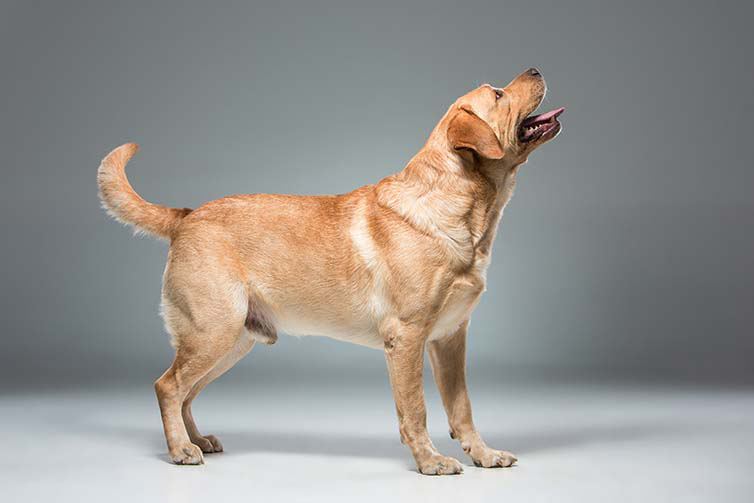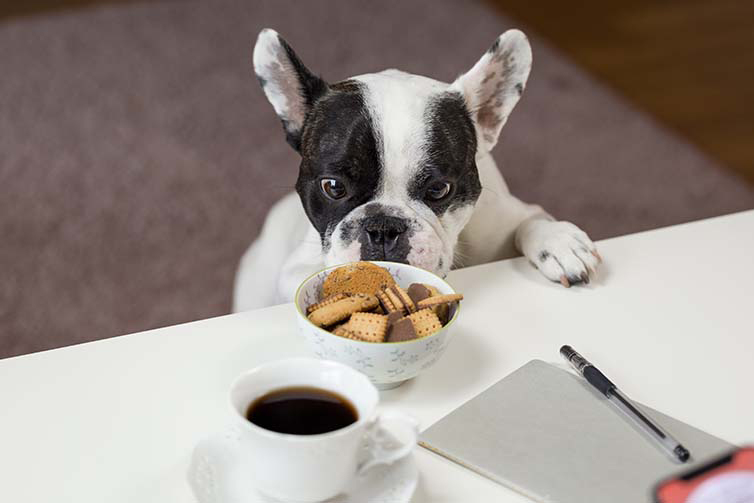Senior dogs
“Will you still need me, will you still feed me, when I’m sixty-four?”
(Lennon and McCartney)

“I first noticed that something was wrong when I walked into my kitchen and Aramis didn’t follow me. I couldn’t understand it, but then, after some time, he didn’t want to jump onto his favourite place on the couch, so I began to lift him. Eventually, he couldn’t jump into the car – he loved going for a ride. Otherwise, he was well and still enjoying his food. I decided to take him to the vet, who, after giving him a thorough examination, pronounced that the only thing ‘wrong’ with Aramis was that he was getting old. The kitchen tiles were slippery and he knew that he might fall because his limbs were not as strong as they were. He didn’t want to leap onto the couch or into the car because he didn’t have the power he used to have. I must say, I was upset at the thought that my beloved Aramis was now an ‘old’ dog, but the vet was very kind and explained that these age-related conditions could be managed. He made some suggestions and I also did some research of my own.
I wanted to share my findings with other doggie parents who might think that they can do nothing about the age-related conditions of their elderly furry friend…”
(Aramis’s Mom)
Our Senior Furry Friends
Many of us are only too aware of the truth in the old saying: “Old-age ain’t for wimps!”. But at the same time, we also know that many Grandpas and Grannies lead active, productive and fulfilling lives. It’s the same with elderly pooches. Some compromises and adjustments obviously have to be made, but a good quality of life can certainly be maintained.
Doggie Years – Human Years
Just how old is your furry friend in human years? You may be surprised to know that the old method of multiplying your dog’s age by seven, is no longer considered by many veterinary associations, to be valid or accurate. According to the American Veterinary Medical Association: the first year of a medium-sized pooch is equal to approximately 15 years of a human’s life. The second year is approximately equal to 9 human years. Then, every 4-5 years of a dog’s life equals around one human year.
Why is this? Why has it changed?
In the early years, a dog’s growth to maturity is very rapid, compared to a human’s growth. To complicate things further, ageing in doggies also depends on their size. For example, a small dog of 12 years is around 64 human years; a large dog of the same age is about 77 human years. (To calculate your poochie’s ‘human age’, go to: akc, “How to calculate dog years to human years.”) So, a small dog would be considered ‘senior’ at about 8/9 years old, while a large dog is a ‘senior’ at around 6/7 years old. These figures are, of course, approximate because ‘age’ is also dependent on health, lifestyle, nutrition, exercise, and so on.
So… what can you actually DO to help your friend when he/she is approaching their Golden Years?
How can you try to ensure that he/she has the best quality of life possible?
Let’s look at some of the problems your dog may face and some suggestions as to how you may deal with them.
A Baseline Health Check

Let’s imagine Chanel, a beautiful Golden Labrador, who has had fairly regular health checks, once a year. As she ages, she may begin to suffer from some physical and mental problems, such as loss of hearing, impaired mobility, loss of vision, organ problems and various lumps and bumps. If you and your vet ‘know’ Chanel, both physically and mentally, from an early age, you and your vet will be more likely to pick up problems as they arise, and deal with them. She should have a health check by the vet, at least once a year, in order to establish a ‘baseline’ assessment.
Chanel, for example, has had a few lumps and bumps over the years. Her vet has made a note of all of these, with a description of each, with its size, colour and results of tests. When her mommy rushes in to the vet with her, just before closing time on a Sunday (It’s always on a Sunday) having a panic attack about a ‘sinister-looking tumour’ she has found on her back, the vet can check Chanel’s records and assure her mommy (now breathing into a brown paper bag) that the ‘tumour’ is a harmless fatty lump that has not changed since her last check.
Weight Control

Chanel has always loved her food and knows when it’s dinner-time, when she sits by the kitchen door, looking at her mom with those pleading eyes which cannot be ignored.
She loves her kibble, laced with tinned food and delicious gravy. (She’s also, like many Labradors, partial to the odd shoe, but let’s not go into that…) Chanel’s mom also supplements her diet sometimes with the family’s left-over spaghetti, lasagne, and apple pie. Yum, yum! Woof, woof! Fortunately, Chanel has always been a very active, healthy dog, but lately, as she approaches doggy middle age, she seems to be looking a wee bit on the podgy side…
As she ages she will, of course, become less active. She will burn up less calories, and we all know what happens to those excess calories, don’t we? Yes, Chanel, like many of us, will begin to gain weight. Slowly and perhaps unnoticed at first…., slinky, svelte and slim Chanel may become a pudding, contributing to her mobility and health problems.
So, what can you do to avoid this situation?
Basically, weight-loss and weight-maintenance can be achieved for Chanel in a similar way to human weight-loss and maintenance. Her calorie intake should be reduced, but not to the detriment of healthy nutrition. Always consult your vet before changing your dog’s diet. She will also provide you with information about a suitable weight-loss and maintenance diet for your poochie. Once the excess weight is lost, your vet will help you with a maintenance diet to ensure that she remains as slim and trim as possible. In all likelihood, this will mean switching to a special kibble intended for senior dogs with weight issues. Tinned dog food may have to be removed from her diet, along with the lasagne, spaghetti and apple pie. Human food is not intended for dogs and is riddled with calories. We have actually taught our dogs to enjoy carbohydrates.
Mobility
Larger breeds, like Chanel, are often more likely to develop mobility problems, caused by such conditions as arthritis. Carrying excess weight will put more strain on arthritic limbs. There are three main ways of dealing with this:
- Keep Excess Weight Off
Excess weight puts additional strain on the limbs and joints, especially if they are arthritic.
- Regular Exercise
It’s easy to let Chanel become more sedentary. She may not be inclined to move and her mom or dad doesn’t want to disturb her, realising that any exercise is painful for her. Arthritis occurs when the cartilage which cushions the joints and bones, begins to wear away. Bones begin to rub against each other, which is, of course, painful. A gentle and slow exercise programme, consisting of shorter, slower and regular walks, will help to prevent stiffness and will also burn up those extra calories. Walking will also provide her with more stimulation which helps to keep her brain alert.
- Supplements
Glucosamine and chondroitin may help to ease arthritic joints, and omega-3 fatty acids might keep your pooch more mobile. You should ask your vet about any supplements. While there is no cure for arthritis, there are treatments which can help to improve mobility. Glucosamine may help to reduce pain and joint wear by helping to repair the damaged cartilage. Chondroitin works in a similar way. Scientific studies have not proved that glucosamine is effective but there are many doggie parents who have found this supplement helpful. Again, your vet will advise you.
Hearing and Vision Loss
With age, in humans too, the tiny little hairs that vibrate in the inner ear in order to transmit sound, may become damaged, resulting in hearing loss. If you suspect that your poochie may not be hearing too well, your vet may check for inflammation in the ear canal, or perhaps a discharge. If the hearing loss is age-related, however, it cannot be treated.
If you see that your doggie’s eyes seem to be looking ‘grey’, your vet will be able to determine whether this is a result of normal ageing, which does not affect vision, or if it is cataracts. She may advise you to consult a veterinary ophthalmologist who will check for PRA, progressive retinal atrophy, a genetic disorder. There is currently no cure for PRA, but cataracts may be removed surgically. This, however, depends on the age and health condition of poochie, for whom a general anaesthetic and surgery may not be advisable.
To us, becoming deaf and/or blind sounds like the-end-of-the-world. To dogs …. not so much. Let’s consider a dog’s sense of smell. Scientists cannot give an exact figure, but it is estimated to be between 10,000 and 100,000 times as strong as ours. 10,000 times, at least! How incredible. We have around 6 million smell receptors, dogs have …wait for it… 300 million. Their sensory world is very different from ours. When we are in a new place we look around at everything; dogs sniff. Because of the sensitivity of this extraordinary sense, it becomes the most important. If humans lose their sight or hearing, they may, at least initially, become less independent and grieve the loss of one of these most important human senses; when a dog loses his/her sight or hearing, he/she can compensate, to a great extent, by sniffing. In other words, dogs can live happy and fulfilling lives whether blind and/or deaf.
Let’s look at some of the things you can do to help…
Try to be patient
Those dogs who lose their sight or hearing over time have the advantage of getting used to it; for those who suddenly become blind or deaf, it will take them some time to adapt. Veterinarian Dr Rhea Morgan, says that blindness in a dog is sometimes only discovered after the mom or dad moves home or buys new furniture and notices that their doggie is bumping into furniture… It is incredible how well and how quickly they learn to deal with their blindness or deafness. But they will take a little longer to navigate, so patience is the key. Always use an encouraging tone of voice and praise every little advancement.
Try to be consistent.
Blind or deaf poochies prefer stable and predictable routine rather than change and instability. Blind dogs particularly rely a lot on their memory of where things were. Here are some tips:
- Try not to move furniture around if possible. Your pet relies on his/her mental picture, or ‘mind map’, of the way the house looked. The deaf dog too will find it easier to cope in familiar territory. If you move a table, put it back. Keep indoor doors open if possible – it’s easier than keeping them closed.
- Try not to make big changes in your garden, for the same reason.
- If you do make changes, introduce them to your pet a few times so that he/she will create a new ‘mind map’ and feel more confident.
- Stick to routines and keep food and water bowls in the same location. The same applies to your doggie’s bed.
- Keep your home as tidy as possible. Poochie has his/her regular route around the house and may trip over toys, shoes, clothes, left around.
- Stick to a regular routine with regard to feeding and walking.
- Let your doggie walk around your house and resist the temptation to carry him/her. Walking slowly around the house will help your pet to make a ‘mind map’.
Safety Measures
- Look carefully around your home, from your dog’s point-of-view.
- Check for any potentially dangerous, sharp objects, like corners, broken hinges on doors, broken glass – clean it up straight away. Keep kitchen cupboards closed.
- Use baby gates to cut off stairs, balconies and other potentially ‘dangerous’ areas.
- Ensure that your swimming pool and any ponds or water features are not accessible.
- Doggie ‘steps’ are available, which will help your pet to climb onto a bed, couch or into the car, safely.
- If poochie is afraid of slipping on smooth floors, trim the hair off from round his/her paws and toes. The foot pads will then be able to get a grip. Try not to use slippery polish on floors and remove any small, loose rugs.
Talking
If your dog is blind and has at least some hearing, your voice will guide him/her and help with orientation. Your voice has always been very important and a source of comfort and security to your pooch.
Bells and I.D.
If your dog gets lost, he/she will not be able to find the way home. Ensure that your pet is microchipped and has a collar with your name, phone number and stating their disability, firmly attached. You may want to attach a small bell to poochie’s collar too, so at least in your home, you can hear where your pet is.
Avoid startling
Suddenly touching a blind or deaf dog can startle them and cause anxiety. Approach your pet slowly and perhaps tap on his bed or the couch, lightly. Poochie can feel the vibration and will not be shocked into waking.
Leashes and Harnesses
Blind or deaf dogs should always be on a harness and leash when outside your home. Dogs without hearing or sight cannot detect oncoming danger as well as they used to.
When you take your pet out you must be alert to any possible dangers, like broken glass, broken fences and so on.
Enjoying life!
In spite of the loss of sight or hearing, your poochie still wants to enjoy life. That is his/her instinct. Let him/her take advantage of the wonderful canine gift of smell. This may include: a walk with lots of sniffing; playing games like ‘Hunt the Treat’; toys that squeak; playing with cuddle toys; playing with other dogs, under supervision. Chewing safe ‘bones’ (Not the real ones, please!), toys or healthy treats will satisfy the chewing instinct.
Remember too that you, his/her mom and/or dad, are the most important things in your dog’s life; interaction with you will go a long way towards coping with any disability.
Keeping fit and healthy
A dog who is fed a good, balanced diet, who is exercised daily, who has check-ups at the vet regularly and comes from a safe and loving home, is going to cope far better with the ageing process and with any disabilities.
Parasite control is especially important for our senior dogs, because they can’t fight off diseases often carried by ticks, fleas and other nasties. Bravecto® Chew will ensure that your dog is free from these external parasites for up to 12 weeks. A dog who is coping with age-related problems does not need the added irritation of almost-constant scratching and possibly injuring his/her skin.
Cognitive Issues
We need to consider how your pet’s ageing process may affect his mental, or cognitive functions. The harsh reality is that, as with humans, as the brain ages, it can result in behavioural changes such as confusion, disorientation, anxiety, less interaction, increased barking, decrease in self-grooming and incontinence. These are the signs of senility, which in dogs is called CCD, or canine cognitive disorder. But before you assume that your furry friend has this disorder, consult with your vet. These symptoms can be the result of several other medical conditions which may be easily treated. If your vet diagnoses CCD, there are some treatments available, which your vet will discuss with you.
How can you deal with this condition? It may be hard for you to cope with the symptoms of CCD, especially with issues like confusion and incontinence. Your vet will give you advice and may refer you to an animal behaviourist to help.
But fundamentally, we should bear in mind that our faithful old companion is still there. alive and kicking, and still capable of enjoying a good quality of life for some years, with you. Sharing your furry friend’s Golden Years is a privilege, and you may find that you develop an extra-special relationship with him/her.
Finally, we hope that our suggestions will help those of you who were dreading the onset of old age in your beloved canine companion. There are, as we have discussed, many ways that you can help both of you to deal with this transition and to ensure that a good quality of life is had by your Old Girl/Boy and you.
Sources:
www.ack.org: Senior Dogs…
https://www.wholedogjournal.com: 10 ways…
petplace.com: Living with a blind dog
thebark.com: Canine Dementia
dogquality.com: Coping with sight and hearing loss…
petplace.com: How to care for blind and deaf senior dogs.
ZA-NON-210800014

Subscribe to our Newsletter
Get to know your furry friend better! Sign up for all things dog- or cat-related.
The Hairy Facts about the dreaded hairball
12 April 2021
Help! My dog’s barking mad! Volume 2
12 April 2021
Your Itchy, Scratchy Cat – All About Cat Skin Problems
12 April 2021
The Dog’s Diet: A Bone of contention?
01 April 2021
Mango Fly Worms: How to Spot and Eliminate them
Posted on November 28,2019
Managing Mange And Mites In Your Dog
Posted on June 11,2018
Why Do Cats Purr and How? Learn What Your Cat Is Saying
Posted on October 14,2020
How to Get Rid of Ear Mites in Dogs
Posted on November 06,2019









